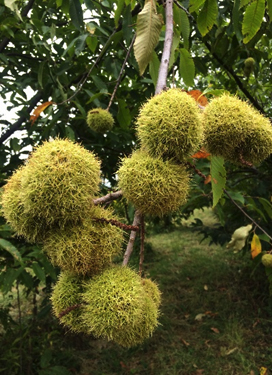 Purdue University - Extension - Forestry and Natural Resources
Purdue University - Extension - Forestry and Natural Resources
Got Nature? Blog

American chestnut fruit protected by a spiny bur. Photo: Dr. Shaneka Lawson, USDA Forest Service, Purdue HTIRC
In the late 1800s, 25% of hardwood trees in North America’s eastern forest were American chestnuts, 40 meters high and two meters across, they provided abundant resources for both people and wildlife in the form of food, shelter and building materials. Lightweight, rot-resistant, straight-grained and easy to work with, chestnut wood was used to build houses, barns, telegraph poles, railroad ties, furniture and even musical instruments. The rapid decline of the chestnut due to the pathogenic fungus Cryphonectria parasitica has been a subject of much debate and despair over the years, but now, chestnuts engineered to battle the fungus might give the iconic trees a chance to reclaim the North American stage.
Research conduced in 2014 was taking genes from wheat, Asian chestnuts, grapes, peppers and other plants and inserting them into American chestnut trees. William Powell of S.U.N.Y.–ESF and scores of collaborators, created hundreds of transgenic trees with the goal of almost 100 percent genetically identical wild American chestnut yet immune to C. parasitica. Testing and gathering data continues to help with future research.
Douglass Jacobs, the Fred M. van Eck Professor of Forest Biology at Purdue University, and a team of scientists at Purdue, use genomics which involves working with the complete set of an organism’s genetic material, to learn more about what causes disease. Genomics also can help identify the genes responsible for useful traits such as pest resistance.
Blight began afflicting the American chestnut in the 1900s, killing billions of trees. Despite being the target of decades-long tree-breeding efforts, the chestnut’s prospects remain in doubt. The list of at-risk species also includes ash, butternut, and bristlecone pine among other members of the five-needle white pine family.
The Hardwood Tree Improvement & Regeneration Center, a joint effort between Purdue and the Forest Service, for years has maintained a breeding program for pest resistance. Almost all of the center’s efforts to date have focused on traditional tree breeding and genomics.
“The chance to work with chestnut and help reintroduce it back to the landscape was a big reason I took the Purdue job in the first place back in December of 2001,” Jacobs said. “Watching species disappear from the landscape provides me personally with a lot of motivation to contribute whatever I can toward helping to save some of these at-risk species.”
To learn more about his research and collaboration with the U.S. Forest Service view full article Biotechnology offers holistic approach to restoration of at-risk forest tree species – Purdue University News, by Purdue Agriculture News.
Resources
A New Generation of American chestnut Trees May Redefine America’s Forests – Scientific American
Consequences of Shifts in Abundance and Distribution of American Chestnut for Restoration of a Foundation Forest Tree – Forests Open Access Forestry Journal
Transgenic American chestnuts show enhanced blight resistance and transmit the trait to T1 progeny – Science Direct (Plant Science)
Scientists Work to Create a Blight-Resistant Chestnut with Hopes of Restoring Tree to America, Forest Service, U.S. Department of Agriculture
FNR Hardwood – American Chestnut, Purdue Arboretum Explorer
Hardwood Tree Improvement Regeneration Center (HTIRC) Research Publications
American Chestnut Trees return to the Hoosier National Forest, Indiana Woodland Steward
Forest Regeneration and Restoration Laboratory, Purdue Forestry and Natural Resources, Dr. Doug Jacobs
Indiana American Chestnut Foundation
Purdue Extension – Forestry and Natural Resources (FNR)

Recent Posts
- A Woodland Management Moment: Black Walnut in Pine Plantation
Posted: December 19, 2025 in Forestry, Forests and Street Trees, Urban Forestry, Woodlands - ID That Tree: Sugarberry
Posted: December 12, 2025 in Forestry, Wildlife, Woodlands - Powering Rural Futures: Purdue’s Agrivoltaics Initiative for Sustainable Growth
Posted: December 9, 2025 in Community Development, Wildlife - Learn How to Control Reed Canarygrass
Posted: December 8, 2025 in Forestry, Invasive Plant Species, Wildlife - Benefits of a Real Christmas Tree, Hoosier Ag Today Podcast
Posted: December 5, 2025 in Christmas Trees, Forestry, Woodlands - Succession Planning Resource: Secure your Future
Posted: December 2, 2025 in Community Development, Land Use, Woodlands - A Woodland Management Moment: Butternut Disease and Breeding
Posted: December 1, 2025 in Forestry, Forests and Street Trees, Woodland Management Moment, Woodlands - Controlling Introduced Cool-Season Grasses
Posted: in Forestry, Invasive Plant Species, Wildlife - Red in Winter – What Are Those Red Fruits I See?
Posted: in Forestry, Plants, Urban Forestry, Wildlife, Woodlands - Managing Common and Cut Leaved Teasel
Posted: November 24, 2025 in Forestry, Invasive Plant Species, Wildlife
Archives
Categories
- Alert
- Aquaculture/Fish
- Aquatic/Aquaculture Resources
- Ask the Expert
- Christmas Trees
- Community Development
- Disease
- Drought
- Forestry
- Forests and Street Trees
- Gardening
- Got Nature for Kids
- Great Lakes
- How To
- Invasive Animal Species
- Invasive Insects
- Invasive Plant Species
- Land Use
- Natural Resource Planning
- Nature of Teaching
- Plants
- Podcasts
- Ponds
- Publication
- Safety
- Spiders
- Timber Marketing
- Uncategorized
- Urban Forestry
- Webinar
- Wildlife
- Wood Products/Manufacturing
- Woodland Management Moment
- Woodlands